Example 16 - Unconformal Faulted Folded Layers
Contents
Example 16 - Unconformal Faulted Folded Layers#
This example will show how to convert the geological map below using GemGIS to a GemPy model. This example is based on digitized data. The area is 3968 m wide (W-E extent) and 2731 m high (N-S extent). The model represents folded and faulted layers (red, yellow, green) as well as layers separated by an unconfirmity (light red to light green) above an unspecified basement (light blue). The vertical model extent varies between 0 m and 1000 m.
The map has been georeferenced with QGIS. The stratigraphic boundaries were digitized in QGIS. Strikes lines were digitized in QGIS as well and will be used to calculate orientations for the GemPy model. The contour lines were also digitized and will be interpolated with GemGIS to create a topography for the model.
Map Source: An Introduction to Geological Structures and Maps by G.M. Bennison
[1]:
import matplotlib.pyplot as plt
import matplotlib.image as mpimg
img = mpimg.imread('../images/cover_example16.png')
plt.figure(figsize=(10, 10))
imgplot = plt.imshow(img)
plt.axis('off')
plt.tight_layout()
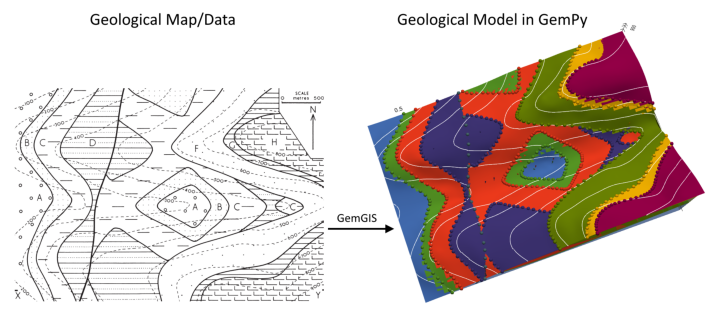
Licensing#
Computational Geosciences and Reservoir Engineering, RWTH Aachen University, Authors: Alexander Juestel. For more information contact: alexander.juestel(at)rwth-aachen.de
This work is licensed under a Creative Commons Attribution 4.0 International License (http://creativecommons.org/licenses/by/4.0/)
Import GemGIS#
If you have installed GemGIS via pip or conda, you can import GemGIS like any other package. If you have downloaded the repository, append the path to the directory where the GemGIS repository is stored and then import GemGIS.
[2]:
import warnings
warnings.filterwarnings("ignore")
import gemgis as gg
Importing Libraries and loading Data#
All remaining packages can be loaded in order to prepare the data and to construct the model. The example data is downloaded from an external server using pooch. It will be stored in a data folder in the same directory where this notebook is stored.
[3]:
import geopandas as gpd
import rasterio
[4]:
file_path = 'data/example16/'
gg.download_gemgis_data.download_tutorial_data(filename="example16_all_features.zip", dirpath=file_path)
Creating Digital Elevation Model from Contour Lines#
The digital elevation model (DEM) will be created by interpolating contour lines digitized from the georeferenced map using the SciPy Radial Basis Function interpolation wrapped in GemGIS. The respective function used for that is gg.vector.interpolate_raster().
[5]:
import matplotlib.pyplot as plt
import matplotlib.image as mpimg
img = mpimg.imread('../images/dem_example16.png')
plt.figure(figsize=(10, 10))
imgplot = plt.imshow(img)
plt.axis('off')
plt.tight_layout()
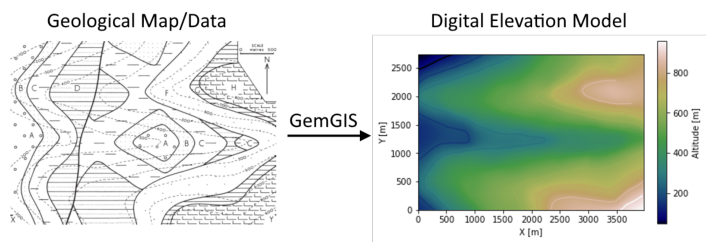
[6]:
topo = gpd.read_file(file_path + 'topo16.shp')
topo.head()
[6]:
| id | Z | geometry | |
|---|---|---|---|
| 0 | None | 200 | LINESTRING (1.591 265.171, 32.840 230.967, 79.... |
| 1 | None | 200 | LINESTRING (2.436 851.918, 33.473 889.712, 73.... |
| 2 | None | 100 | LINESTRING (1.803 2469.855, 62.188 2493.502, 1... |
| 3 | None | 200 | LINESTRING (2.014 2215.436, 17.849 2238.028, 6... |
| 4 | None | 900 | LINESTRING (3559.448 2.095, 3595.764 16.875, 3... |
Interpolating the contour lines#
[7]:
topo_raster = gg.vector.interpolate_raster(gdf=topo, value='Z', method='rbf', res=10)
Plotting the raster#
[8]:
import matplotlib.pyplot as plt
from mpl_toolkits.axes_grid1 import make_axes_locatable
fix, ax = plt.subplots(1, figsize=(10, 10))
topo.plot(ax=ax, aspect='equal', column='Z', cmap='gist_earth')
im = plt.imshow(topo_raster, origin='lower', extent=[0, 3968, 0, 2731], cmap='gist_earth')
divider = make_axes_locatable(ax)
cax = divider.append_axes("right", size="5%", pad=0.05)
cbar = plt.colorbar(im, cax=cax)
cbar.set_label('Altitude [m]')
ax.set_xlabel('X [m]')
ax.set_ylabel('Y [m]')
ax.set_xlim(0, 3968)
ax.set_ylim(0, 2731)
[8]:
(0.0, 2731.0)
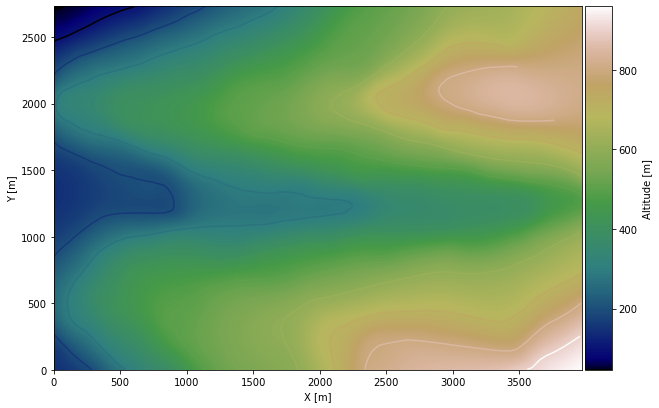
Saving the raster to disc#
After the interpolation of the contour lines, the raster is saved to disc using gg.raster.save_as_tiff(). The function will not be executed as a raster is already provided with the example data.
Opening Raster#
The previously computed and saved raster can now be opened using rasterio.
[9]:
topo_raster = rasterio.open(file_path + 'raster16.tif')
Interface Points of stratigraphic boundaries#
The interface points will be extracted from LineStrings digitized from the georeferenced map using QGIS. It is important to provide a formation name for each layer boundary. The vertical position of the interface point will be extracted from the digital elevation model using the GemGIS function gg.vector.extract_xyz(). The resulting GeoDataFrame now contains single points including the information about the respective formation.
[10]:
import matplotlib.pyplot as plt
import matplotlib.image as mpimg
img = mpimg.imread('../images/interfaces_example16.png')
plt.figure(figsize=(10, 10))
imgplot = plt.imshow(img)
plt.axis('off')
plt.tight_layout()
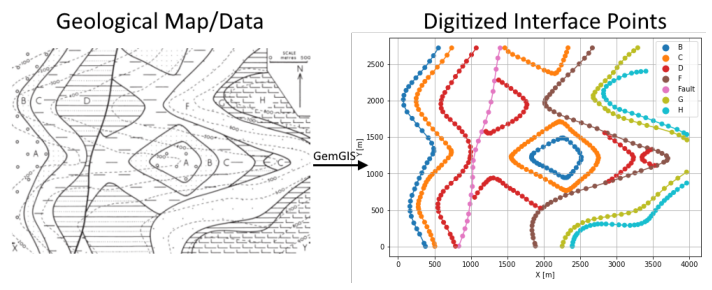
[11]:
interfaces = gpd.read_file(file_path + 'interfaces16.shp')
interfaces.head()
[11]:
| id | formation | geometry | |
|---|---|---|---|
| 0 | None | Fault | LINESTRING (1401.636 2725.330, 1370.388 2586.8... |
| 1 | None | H | LINESTRING (3403.207 2406.937, 3334.799 2401.8... |
| 2 | None | G | LINESTRING (3290.883 2728.708, 3235.987 2687.3... |
| 3 | None | D | LINESTRING (3461.481 1326.764, 3425.165 1298.0... |
| 4 | None | D | LINESTRING (2837.362 1560.703, 2908.304 1494.8... |
Extracting Z coordinate from Digital Elevation Model#
[12]:
interfaces_coords = gg.vector.extract_xyz(gdf=interfaces, dem=topo_raster)
interfaces_coords = interfaces_coords.sort_values(by='formation', ascending=False)
interfaces_coords = interfaces_coords[interfaces_coords['formation'].isin(['Fault', 'B', 'C', 'D', 'G', 'F', 'H'])]
interfaces_coords.head()
[12]:
| formation | geometry | X | Y | Z | |
|---|---|---|---|---|---|
| 351 | H | POINT (3476.260 416.767) | 3476.26 | 416.77 | 699.70 |
| 44 | H | POINT (3711.466 1652.758) | 3711.47 | 1652.76 | 664.07 |
| 359 | H | POINT (3109.728 291.774) | 3109.73 | 291.77 | 747.18 |
| 358 | H | POINT (3185.737 288.818) | 3185.74 | 288.82 | 745.14 |
| 357 | H | POINT (3244.855 294.308) | 3244.86 | 294.31 | 734.68 |
Plotting the Interface Points#
[13]:
fig, ax = plt.subplots(1, figsize=(10, 10))
interfaces.plot(ax=ax, column='formation', legend=True, aspect='equal')
interfaces_coords.plot(ax=ax, column='formation', legend=True, aspect='equal')
plt.grid()
ax.set_xlabel('X [m]')
ax.set_ylabel('Y [m]')
ax.set_xlim(0, 3968)
ax.set_ylim(0, 2731)
[13]:
(0.0, 2731.0)
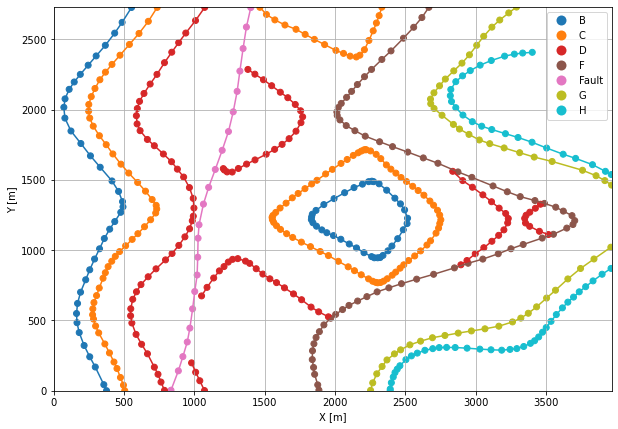
Orientations from Strike Lines#
Strike lines connect outcropping stratigraphic boundaries (interfaces) of the same altitude. In other words: the intersections between topographic contours and stratigraphic boundaries at the surface. The height difference and the horizontal difference between two digitized lines is used to calculate the dip and azimuth and hence an orientation that is necessary for GemPy. In order to calculate the orientations, each set of strikes lines/LineStrings for one formation must be given an id
number next to the altitude of the strike line. The id field is already predefined in QGIS. The strike line with the lowest altitude gets the id number 1, the strike line with the highest altitude the the number according to the number of digitized strike lines. It is currently recommended to use one set of strike lines for each structural element of one formation as illustrated.
[14]:
import matplotlib.pyplot as plt
import matplotlib.image as mpimg
img = mpimg.imread('../images/orientations_example16.png')
plt.figure(figsize=(10, 10))
imgplot = plt.imshow(img)
plt.axis('off')
plt.tight_layout()
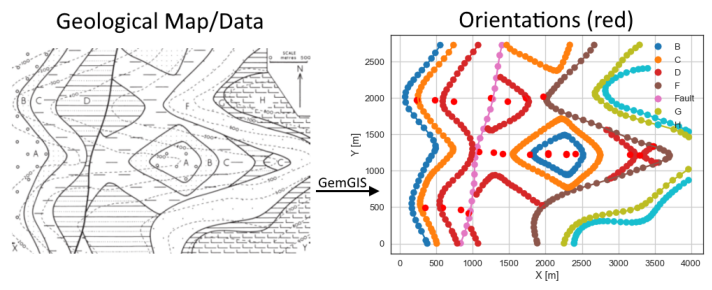
[15]:
strikes = gpd.read_file(file_path + 'strikes16.shp')
strikes.head()
[15]:
| id | formation | Z | geometry | |
|---|---|---|---|---|
| 0 | 1 | Fault2 | 300 | LINESTRING (1369.455 2575.828, 1108.966 1461.029) |
| 1 | 2 | Fault2 | 400 | LINESTRING (1331.187 2325.368, 1176.529 1650.260) |
| 2 | 1 | Fault1 | 400 | LINESTRING (1021.872 873.278, 846.365 36.387) |
| 3 | 2 | Fault1 | 500 | LINESTRING (973.575 482.148, 931.611 286.847) |
| 4 | 2 | B4 | 300 | LINESTRING (92.345 2105.786, 115.570 1859.812) |
Calculate Orientations for each formation#
[16]:
orientations_f1 = gg.vector.calculate_orientations_from_strike_lines(gdf=strikes[strikes['formation'] == 'Fault1'].sort_values(by='Z', ascending=True).reset_index())
orientations_f1
[16]:
| dip | azimuth | Z | geometry | polarity | formation | X | Y | |
|---|---|---|---|---|---|---|---|---|
| 0 | 72.24 | 281.86 | 450.00 | POINT (943.356 419.665) | 1.00 | Fault1 | 943.36 | 419.67 |
[17]:
orientations_f2 = gg.vector.calculate_orientations_from_strike_lines(gdf=strikes[strikes['formation'] == 'Fault2'].sort_values(by='Z', ascending=True).reset_index())
orientations_f2
[17]:
| dip | azimuth | Z | geometry | polarity | formation | X | Y | |
|---|---|---|---|---|---|---|---|---|
| 0 | 78.84 | 283.09 | 350.00 | POINT (1246.534 2003.121) | 1.00 | Fault2 | 1246.53 | 2003.12 |
[18]:
orientations_f3 = gg.vector.calculate_orientations_from_strike_lines(gdf=strikes[strikes['formation'] == 'Fault3'].sort_values(by='Z', ascending=True).reset_index())
orientations_f3
[18]:
| dip | azimuth | Z | geometry | polarity | formation | X | Y | |
|---|---|---|---|---|---|---|---|---|
| 0 | 72.65 | 281.34 | 350.00 | POINT (1084.157 1262.429) | 1.00 | Fault3 | 1084.16 | 1262.43 |
[19]:
orientations_b1 = gg.vector.calculate_orientations_from_strike_lines(gdf=strikes[strikes['formation'] == 'B1'].sort_values(by='Z', ascending=True).reset_index())
orientations_b1
[19]:
| dip | azimuth | Z | geometry | polarity | formation | X | Y | |
|---|---|---|---|---|---|---|---|---|
| 0 | 20.35 | 85.12 | 250.00 | POINT (347.292 491.913) | 1.00 | B1 | 347.29 | 491.91 |
[20]:
orientations_b2 = gg.vector.calculate_orientations_from_strike_lines(gdf=strikes[strikes['formation'] == 'B2'].sort_values(by='Z', ascending=True).reset_index())
orientations_b2
[20]:
| dip | azimuth | Z | geometry | polarity | formation | X | Y | |
|---|---|---|---|---|---|---|---|---|
| 0 | 21.95 | 265.66 | 350.00 | POINT (2029.784 1223.500) | 1.00 | B2 | 2029.78 | 1223.50 |
[21]:
orientations_b3 = gg.vector.calculate_orientations_from_strike_lines(gdf=strikes[strikes['formation'] == 'B3'].sort_values(by='Z', ascending=True).reset_index())
orientations_b3
[21]:
| dip | azimuth | Z | geometry | polarity | formation | X | Y | |
|---|---|---|---|---|---|---|---|---|
| 0 | 0.00 | 85.61 | 400.00 | POINT (2282.355 1220.333) | 1.00 | B3 | 2282.36 | 1220.33 |
[22]:
orientations_b4 = gg.vector.calculate_orientations_from_strike_lines(gdf=strikes[strikes['formation'] == 'B4'].sort_values(by='Z', ascending=True).reset_index())
orientations_b4
[22]:
| dip | azimuth | Z | geometry | polarity | formation | X | Y | |
|---|---|---|---|---|---|---|---|---|
| 0 | 21.87 | 85.18 | 250.00 | POINT (230.639 1970.923) | 1.00 | B4 | 230.64 | 1970.92 |
[23]:
orientations_c1 = gg.vector.calculate_orientations_from_strike_lines(gdf=strikes[strikes['formation'] == 'C1'].sort_values(by='Z', ascending=True).reset_index())
orientations_c1
[23]:
| dip | azimuth | Z | geometry | polarity | formation | X | Y | |
|---|---|---|---|---|---|---|---|---|
| 0 | 22.48 | 85.96 | 250.00 | POINT (585.612 498.643) | 1.00 | C1 | 585.61 | 498.64 |
[24]:
orientations_c2 = gg.vector.calculate_orientations_from_strike_lines(gdf=strikes[strikes['formation'] == 'C2'].sort_values(by='Z', ascending=True).reset_index())
orientations_c2
[24]:
| dip | azimuth | Z | geometry | polarity | formation | X | Y | |
|---|---|---|---|---|---|---|---|---|
| 0 | 22.41 | 264.42 | 350.00 | POINT (1784.602 1228.779) | 1.00 | C2 | 1784.60 | 1228.78 |
| 1 | 0.00 | 0.00 | 400.00 | POINT (2032.159 1240.391) | 1.00 | C2 | 2032.16 | 1240.39 |
[25]:
orientations_c3 = gg.vector.calculate_orientations_from_strike_lines(gdf=strikes[strikes['formation'] == 'C3'].sort_values(by='Z', ascending=True).reset_index())
orientations_c3
[25]:
| dip | azimuth | Z | geometry | polarity | formation | X | Y | |
|---|---|---|---|---|---|---|---|---|
| 0 | 11.47 | 85.21 | 450.00 | POINT (2406.530 1229.571) | 1.00 | C3 | 2406.53 | 1229.57 |
| 1 | 0.00 | 0.00 | 500.00 | POINT (2284.863 1233.002) | 1.00 | C3 | 2284.86 | 1233.00 |
[26]:
orientations_c4 = gg.vector.calculate_orientations_from_strike_lines(gdf=strikes[strikes['formation'] == 'C4'].sort_values(by='Z', ascending=True).reset_index())
orientations_c4
[26]:
| dip | azimuth | Z | geometry | polarity | formation | X | Y | |
|---|---|---|---|---|---|---|---|---|
| 0 | 22.59 | 265.72 | 350.00 | POINT (1723.636 2004.441) | 1.00 | C4 | 1723.64 | 2004.44 |
| 1 | 22.15 | 265.73 | 450.00 | POINT (1968.554 2021.331) | 1.00 | C4 | 1968.55 | 2021.33 |
[27]:
orientations_c5 = gg.vector.calculate_orientations_from_strike_lines(gdf=strikes[strikes['formation'] == 'C5'].sort_values(by='Z', ascending=True).reset_index())
orientations_c5
[27]:
| dip | azimuth | Z | geometry | polarity | formation | X | Y | |
|---|---|---|---|---|---|---|---|---|
| 0 | 21.62 | 85.70 | 250.00 | POINT (475.557 1973.562) | 1.00 | C5 | 475.56 | 1973.56 |
[28]:
orientations_d1 = gg.vector.calculate_orientations_from_strike_lines(gdf=strikes[strikes['formation'] == 'D1'].sort_values(by='Z', ascending=True).reset_index())
orientations_d1
[28]:
| dip | azimuth | Z | geometry | polarity | formation | X | Y | |
|---|---|---|---|---|---|---|---|---|
| 0 | 24.97 | 86.28 | 350.00 | POINT (837.128 468.952) | 1.00 | D1 | 837.13 | 468.95 |
[29]:
orientations_d2 = gg.vector.calculate_orientations_from_strike_lines(gdf=strikes[strikes['formation'] == 'D2'].sort_values(by='Z', ascending=True).reset_index())
orientations_d2
[29]:
| dip | azimuth | Z | geometry | polarity | formation | X | Y | |
|---|---|---|---|---|---|---|---|---|
| 0 | 0.00 | 85.37 | 400.00 | POINT (3288.420 1212.416) | 1.00 | D2 | 3288.42 | 1212.42 |
| 1 | 11.25 | 0.00 | 450.00 | POINT (3159.890 1219.542) | 1.00 | D2 | 3159.89 | 1219.54 |
[30]:
orientations_d3 = gg.vector.calculate_orientations_from_strike_lines(gdf=strikes[strikes['formation'] == 'D3'].sort_values(by='Z', ascending=True).reset_index())
orientations_d3
[30]:
| dip | azimuth | Z | geometry | polarity | formation | X | Y | |
|---|---|---|---|---|---|---|---|---|
| 0 | 22.81 | 266.11 | 450.00 | POINT (1481.621 1955.879) | 1.00 | D3 | 1481.62 | 1955.88 |
[31]:
orientations_d4 = gg.vector.calculate_orientations_from_strike_lines(gdf=strikes[strikes['formation'] == 'D4'].sort_values(by='Z', ascending=True).reset_index())
orientations_d4
[31]:
| dip | azimuth | Z | geometry | polarity | formation | X | Y | |
|---|---|---|---|---|---|---|---|---|
| 0 | 0.00 | 265.65 | 400.00 | POINT (1283.945 1251.212) | 1.00 | D4 | 1283.94 | 1251.21 |
| 1 | 11.48 | 0.00 | 450.00 | POINT (1407.460 1235.905) | 1.00 | D4 | 1407.46 | 1235.90 |
[32]:
orientations_d5 = gg.vector.calculate_orientations_from_strike_lines(gdf=strikes[strikes['formation'] == 'D5'].sort_values(by='Z', ascending=True).reset_index())
orientations_d5
[32]:
| dip | azimuth | Z | geometry | polarity | formation | X | Y | |
|---|---|---|---|---|---|---|---|---|
| 0 | 23.00 | 84.84 | 350.00 | POINT (735.783 1952.448) | 1.00 | D5 | 735.78 | 1952.45 |
[33]:
orientations_g = gg.vector.calculate_orientations_from_strike_lines(gdf=strikes[strikes['formation'] == 'G'].sort_values(by='Z', ascending=True).reset_index())
orientations_g
[33]:
| dip | azimuth | Z | geometry | polarity | formation | X | Y | |
|---|---|---|---|---|---|---|---|---|
| 0 | 5.85 | 89.87 | 650.00 | POINT (3475.011 1339.361) | 1.00 | G | 3475.01 | 1339.36 |
Merging Orientations#
[34]:
import pandas as pd
orientations = pd.concat([orientations_f1, orientations_f2, orientations_f3, orientations_b1, orientations_b2, orientations_b3, orientations_b4, orientations_c1, orientations_c2, orientations_c3, orientations_c4, orientations_c5, orientations_d1, orientations_d2, orientations_d3, orientations_d4, orientations_d5, orientations_g]).reset_index()
orientations['formation'] = ['Fault', 'Fault', 'Fault', 'B', 'B', 'B', 'B', 'C', 'C', 'C', 'C', 'C', 'C', 'C', 'C', 'D', 'D', 'D', 'D', 'D', 'D', 'D', 'G']
orientations = orientations[orientations['formation'].isin(['Fault', 'B', 'C', 'D', 'G'])]
orientations.head()
[34]:
| index | dip | azimuth | Z | geometry | polarity | formation | X | Y | |
|---|---|---|---|---|---|---|---|---|---|
| 0 | 0 | 72.24 | 281.86 | 450.00 | POINT (943.356 419.665) | 1.00 | Fault | 943.36 | 419.67 |
| 1 | 0 | 78.84 | 283.09 | 350.00 | POINT (1246.534 2003.121) | 1.00 | Fault | 1246.53 | 2003.12 |
| 2 | 0 | 72.65 | 281.34 | 350.00 | POINT (1084.157 1262.429) | 1.00 | Fault | 1084.16 | 1262.43 |
| 3 | 0 | 20.35 | 85.12 | 250.00 | POINT (347.292 491.913) | 1.00 | B | 347.29 | 491.91 |
| 4 | 0 | 21.95 | 265.66 | 350.00 | POINT (2029.784 1223.500) | 1.00 | B | 2029.78 | 1223.50 |
Plotting the Orientations#
[35]:
fig, ax = plt.subplots(1, figsize=(10, 10))
interfaces.plot(ax=ax, column='formation', legend=True, aspect='equal')
interfaces_coords.plot(ax=ax, column='formation', legend=True, aspect='equal')
orientations.plot(ax=ax, color='red', aspect='equal')
plt.grid()
import matplotlib.pyplot as plt
import matplotlib.image as mpimg
img = mpimg.imread('../images/orientations_example16.png')
plt.figure(figsize=(10, 10))
imgplot = plt.imshow(img)
plt.axis('off')
plt.tight_layout()


GemPy Model Construction#
The structural geological model will be constructed using the GemPy package.
[36]:
import gempy as gp
WARNING (theano.configdefaults): g++ not available, if using conda: `conda install m2w64-toolchain`
WARNING (theano.configdefaults): g++ not detected ! Theano will be unable to execute optimized C-implementations (for both CPU and GPU) and will default to Python implementations. Performance will be severely degraded. To remove this warning, set Theano flags cxx to an empty string.
WARNING (theano.tensor.blas): Using NumPy C-API based implementation for BLAS functions.
Creating new Model#
[37]:
geo_model = gp.create_model('Model16')
geo_model
[37]:
Model16 2022-04-05 11:10
Initiate Data#
[38]:
gp.init_data(geo_model, [0, 3968, 0, 2731, 0, 1000], [100, 100, 100],
surface_points_df=interfaces_coords[interfaces_coords['Z'] != 0],
orientations_df=orientations,
default_values=True)
Active grids: ['regular']
[38]:
Model16 2022-04-05 11:10
Model Surfaces#
[39]:
geo_model.surfaces
[39]:
| surface | series | order_surfaces | color | id | |
|---|---|---|---|---|---|
| 0 | H | Default series | 1 | #015482 | 1 |
| 1 | G | Default series | 2 | #9f0052 | 2 |
| 2 | Fault | Default series | 3 | #ffbe00 | 3 |
| 3 | F | Default series | 4 | #728f02 | 4 |
| 4 | D | Default series | 5 | #443988 | 5 |
| 5 | C | Default series | 6 | #ff3f20 | 6 |
| 6 | B | Default series | 7 | #5DA629 | 7 |
Mapping the Stack to Surfaces#
[40]:
gp.map_stack_to_surfaces(geo_model,
{
'Fault1': ('Fault'),
'Strata1': ('H', 'G', 'F'),
'Strata2': ('D', 'C', 'B'),
},
remove_unused_series=True)
geo_model.add_surfaces('A')
geo_model.set_is_fault(['Fault1'])
Fault colors changed. If you do not like this behavior, set change_color to False.
[40]:
| order_series | BottomRelation | isActive | isFault | isFinite | |
|---|---|---|---|---|---|
| Fault1 | 1 | Fault | True | True | False |
| Strata1 | 2 | Erosion | True | False | False |
| Strata2 | 3 | Erosion | True | False | False |
Showing the Number of Data Points#
[41]:
gg.utils.show_number_of_data_points(geo_model=geo_model)
[41]:
| surface | series | order_surfaces | color | id | No. of Interfaces | No. of Orientations | |
|---|---|---|---|---|---|---|---|
| 2 | Fault | Fault1 | 1 | #527682 | 1 | 22 | 3 |
| 0 | H | Strata1 | 1 | #9f0052 | 2 | 63 | 0 |
| 1 | G | Strata1 | 2 | #ffbe00 | 3 | 54 | 1 |
| 3 | F | Strata1 | 3 | #728f02 | 4 | 66 | 0 |
| 4 | D | Strata2 | 1 | #443988 | 5 | 116 | 7 |
| 5 | C | Strata2 | 2 | #ff3f20 | 6 | 139 | 8 |
| 6 | B | Strata2 | 3 | #5DA629 | 7 | 75 | 4 |
| 7 | A | Strata2 | 4 | #4878d0 | 8 | 0 | 0 |
Loading Digital Elevation Model#
[42]:
geo_model.set_topography(
source='gdal', filepath=file_path + 'raster16.tif')
Cropped raster to geo_model.grid.extent.
depending on the size of the raster, this can take a while...
storing converted file...
Active grids: ['regular' 'topography']
[42]:
Grid Object. Values:
array([[ 19.84 , 13.655 , 5. ],
[ 19.84 , 13.655 , 15. ],
[ 19.84 , 13.655 , 25. ],
...,
[3963.00251889, 2705.99084249, 744.06182861],
[3963.00251889, 2715.99450549, 742.93560791],
[3963.00251889, 2725.9981685 , 741.82879639]])
Plotting Input Data#
[43]:
gp.plot_2d(geo_model, direction='z', show_lith=False, show_boundaries=False)
plt.grid()

[44]:
gp.plot_3d(geo_model, image=False, plotter_type='basic', notebook=True)
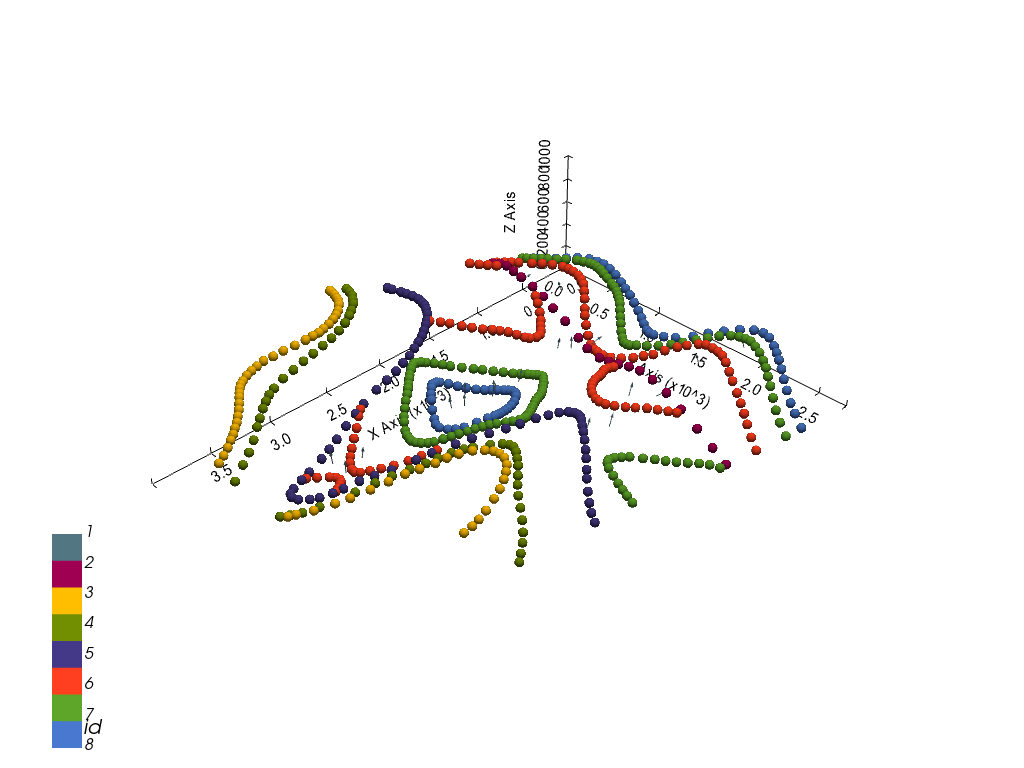
[44]:
<gempy.plot.vista.GemPyToVista at 0x20a4d850f40>
Setting the Interpolator#
[45]:
gp.set_interpolator(geo_model,
compile_theano=True,
theano_optimizer='fast_compile',
verbose=[],
update_kriging=False
)
Compiling theano function...
Level of Optimization: fast_compile
Device: cpu
Precision: float64
Number of faults: 1
Compilation Done!
Kriging values:
values
range 4919.69
$C_o$ 576271.07
drift equations [3, 3, 3]
[45]:
<gempy.core.interpolator.InterpolatorModel at 0x20a4b61e9a0>
Computing Model#
[46]:
sol = gp.compute_model(geo_model, compute_mesh=True)
Plotting Cross Sections#
[47]:
gp.plot_2d(geo_model, direction=['x', 'x', 'y', 'y'], cell_number=[25, 75, 25, 75], show_topography=True, show_data=False)
[47]:
<gempy.plot.visualization_2d.Plot2D at 0x20a4c1c94f0>
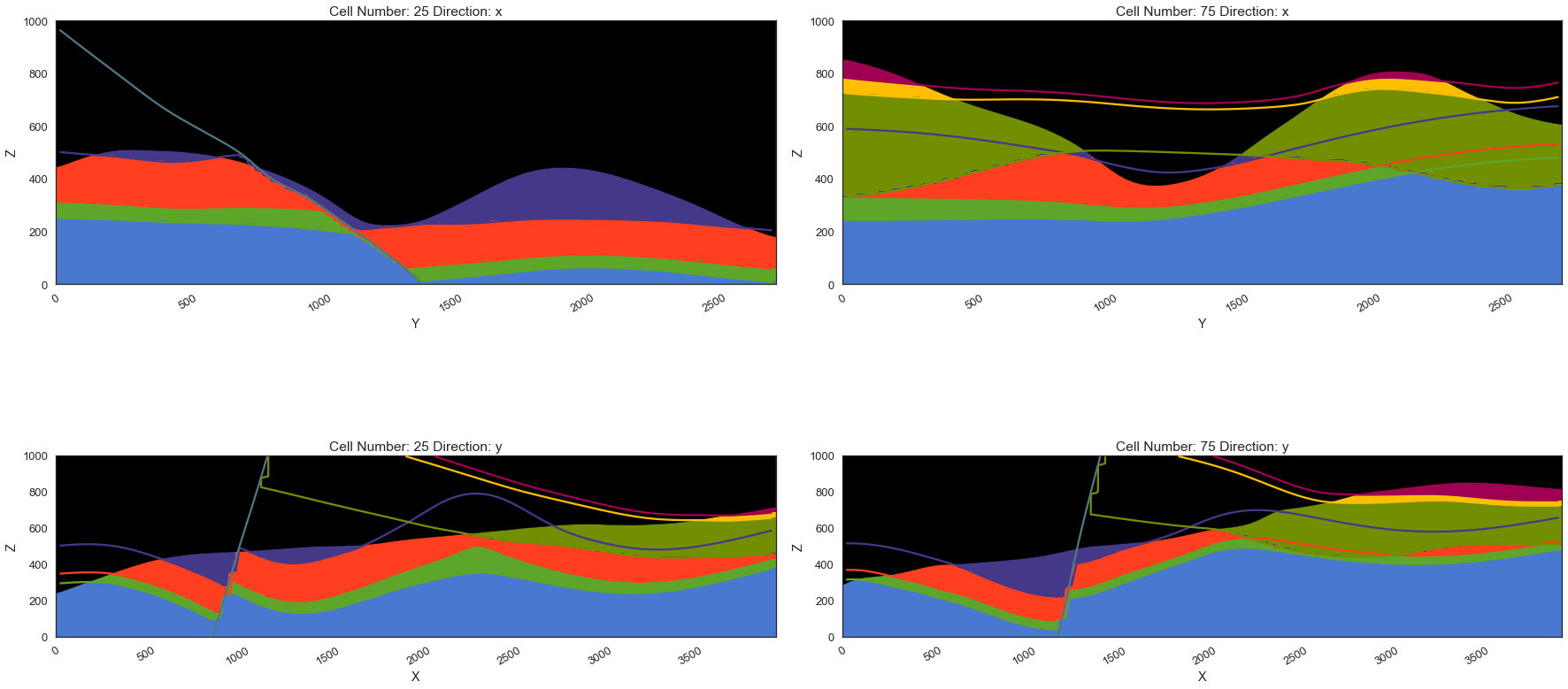
Plotting 3D Model#
[48]:
gpv = gp.plot_3d(geo_model, image=False, show_topography=True,
plotter_type='basic', notebook=True, show_lith=True)
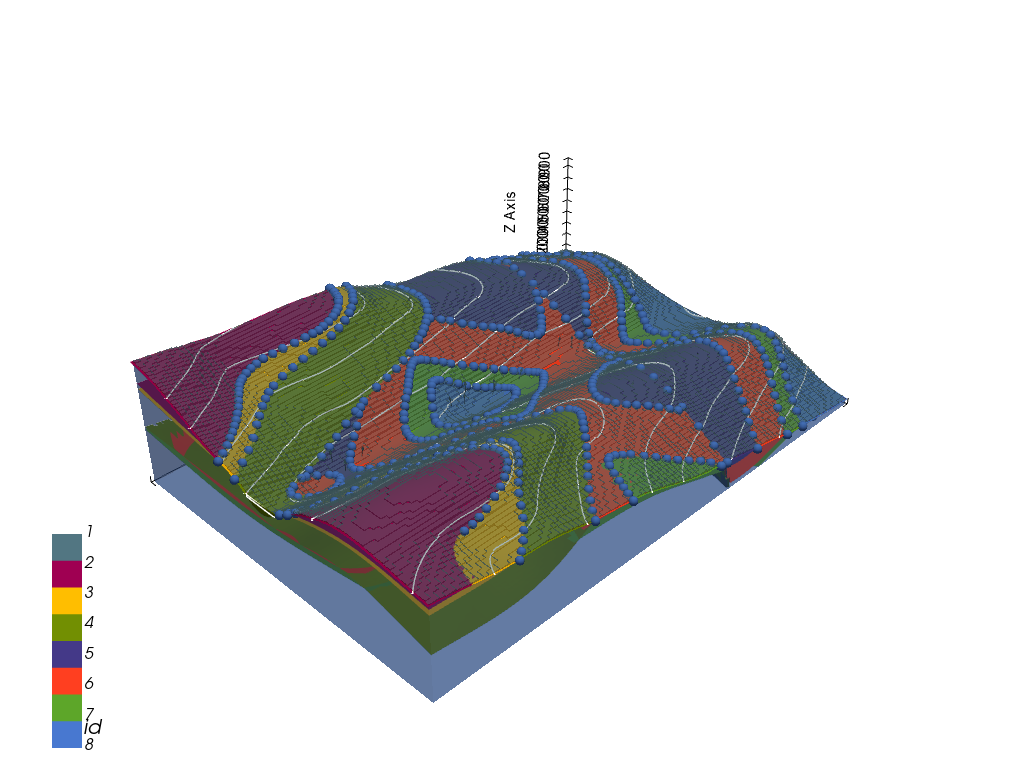
[ ]:
